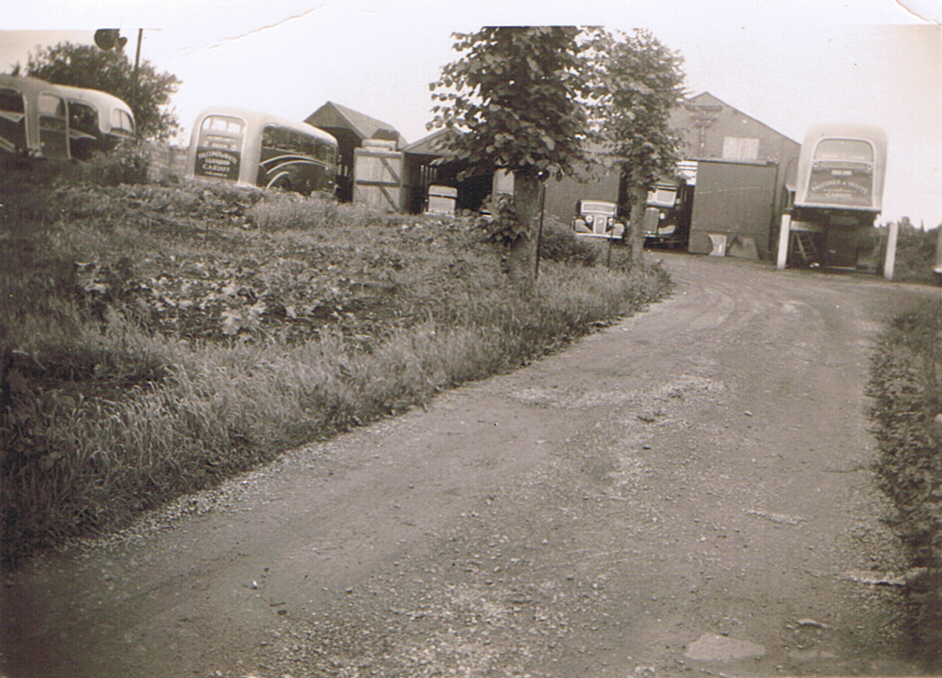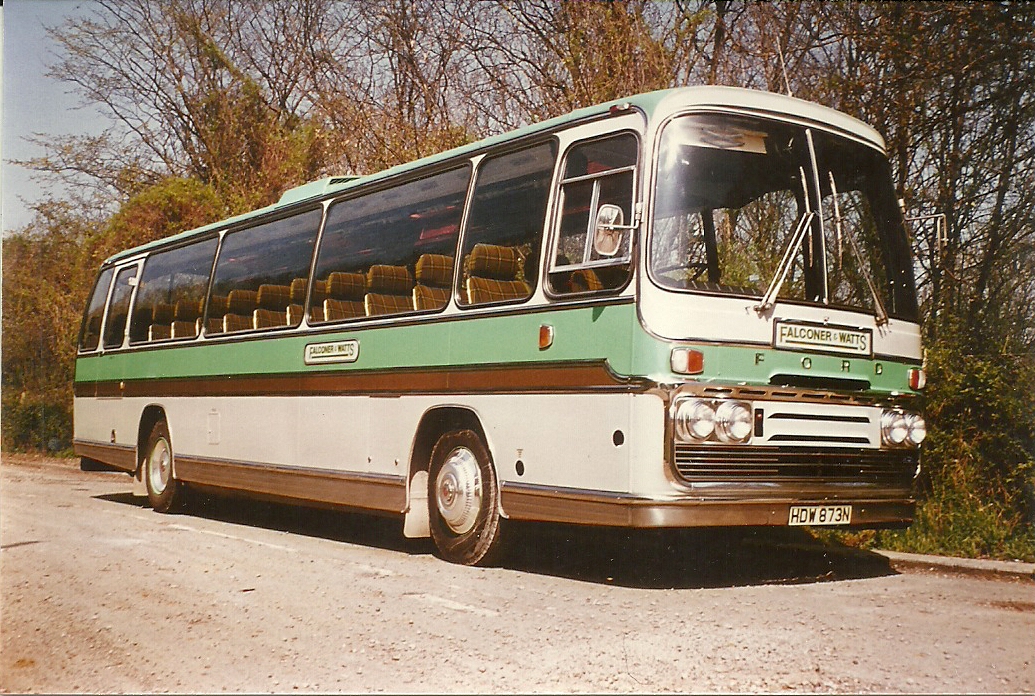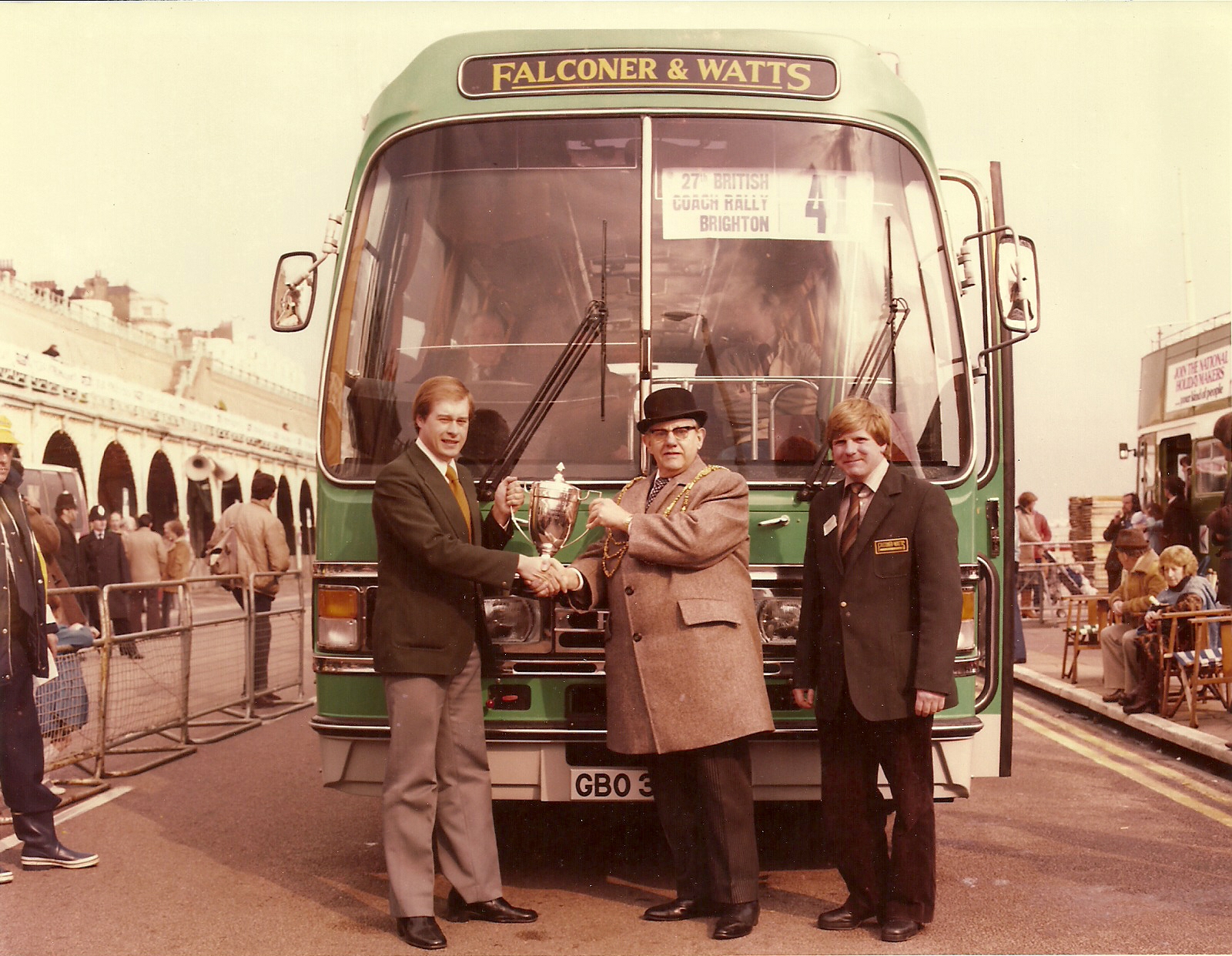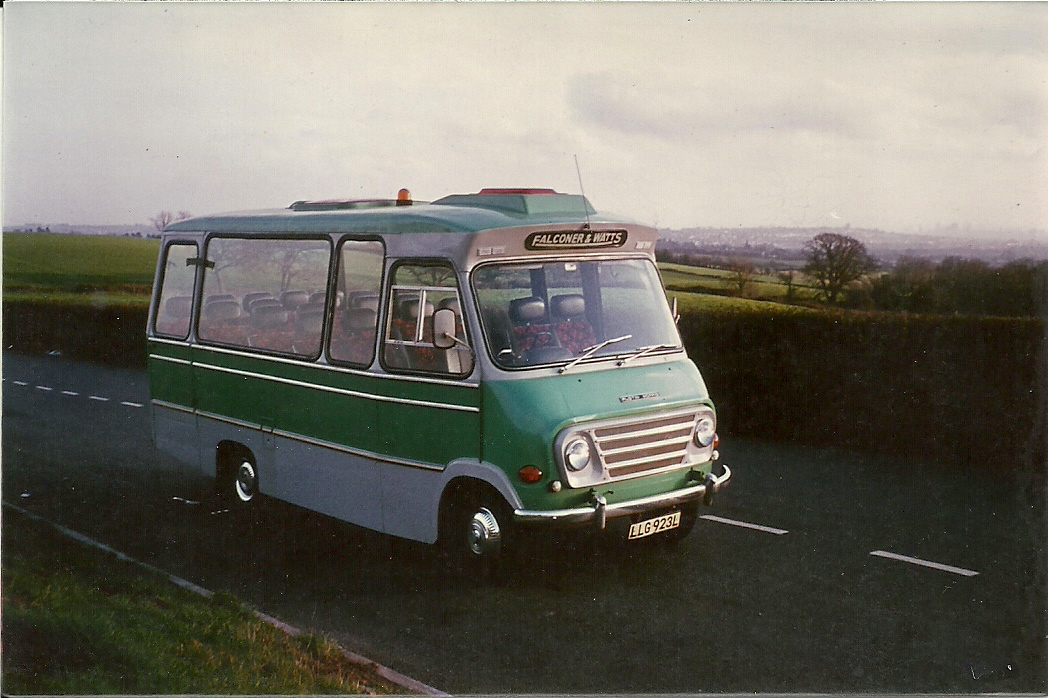A suburban coach operator in Wales’ capital
STARTING UP
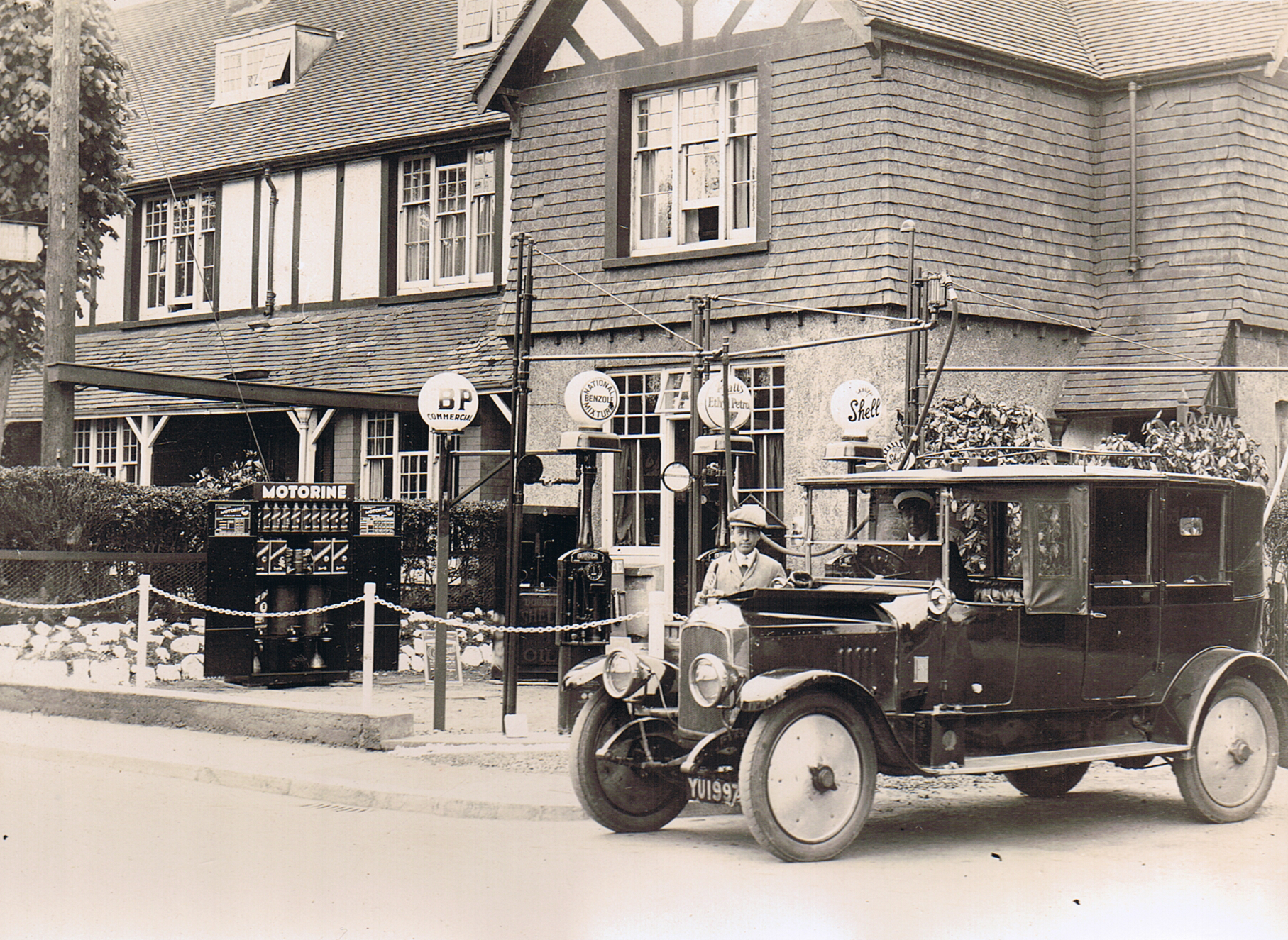
Falconer and Watts was one of the many small British companies that started almost immediately after the First World War.
In 1919, Percy William Watts and Albert Falconer, who had been in the Army together, opened a small taxi business in Llanishen, at that time a small village around four miles to the north of the centre of Cardiff. Cardiff was then flourishing as a major port, and was around this time the world’s leading coal port. Over the following decades, Cardiff increased in size, absorbing many outlying villages including Llanishen, to became Wales’ capital in the mid-fifties.
The first premises were shared with Ernie Yapp, in a small lane running parallel to Fidlas Road, but accessed from Station Road, the main road running through Llanishen village. However, very soon, Ernie Yapp decided his main interest was in car sales, and moved to other premises in Fidlas Road, beside the embankment carrying the railway line between Cardiff and Caerphilly.
Soon after the company started, a petrol filling station with a small shop was opened in the middle of Llanishen village. This was in Station Road, adjacent to the lane giving access to the taxi garage, and, initially, had only one hand-pump serving petrol.
In 1922, a second-hand Fiat 14-seater coach was purchased from Charlie Hinton, a coach operator based in Cardiff. Because of this and the need for more space for the taxis and wedding cars, it was clear that larger premises were needed.
New premises to the rear of the filling station in Station Road were leased in the mid-twenties. They consisted of a large raised area surrounded by orchards, adjoining some land originally used by a local bank as tennis courts, but later serving as grazing for a small donkey. The number of buildings on the site was increased over the years, until, by the sixties, there were around five or six small lock-up garages each for one car, two larger garages each for one coach, and a large building that could garage three coaches, together with a maintenance pit. Some of the buildings were erected during the Second World War as “temporary structures,” but lasted well into the 1970s. There was also plenty of parking space for cars and coaches (and an occasional lorry), and a large exterior electric ramp.
It has been suggested that Falconer and Watts once operated from a large garage at the southern end of Kimberley Terrace in Llanishen (although a smaller garage in this street was certainly once used to house the wedding cars). This larger garage may have been used at one time by Worrell’s, another local coach company, and is currently used by R. H. Babbage & Son Ltd. (as at November 2015), who held the maintenance contract for Falconer & Watts’ coaches for many years. No-one seems sure about Falconer & Watts’ use of these premises, however.
During these early years, many coaches were purchased from local operators such as Charlie Hinton and Cridland’s (there was probably little of a dealer network in those days). The first fifteen coaches purchased, from 1922 to 1936, were a mixed bag that included many Continental makes. After the Fiat, came three Crossleys, three Berliets, three Reos, two Lancias, a Bean, a Clement-Talbot and a Leyland.
It was in the mid-twenties that Albert died from pneumonia, and, on March 12 1925, his father, William Graham Falconer, was instrumental in arranging for Albert’s brother, Edgar, to move down from London to take over the partnership with Percy Watts. Another of Albert’s brothers, Ronald, was made a junior partner around two months later on May 25 1925, but he left the company fairly soon after. Details about the company are very sketchy during these early years, and the reasons for Ronald’s departure are particularly obscure.
In 1927, there was a serious fire at the main garage (Graham Falconer, Edgar’s son, is sure of the year as the shock almost brought on his birth prematurely!). This building, on the new site behind Station Road, was largely wooden, and was totally destroyed by the fire, resulting in the destruction of four cars. This was reported in the Western Mail (a photograph survives).
Nevertheless, business progressed satisfactorily over the years and the coach and car fleet increased. One old newspaper advertisement for Falconer & Watts even boasted “any make of car supplied”!
EXPANSION
BDL 322 was the first coach to carry the golden brown and light buff livery that was used until the 1960s
(photograph copyright Rob Falconer)
More details are available of the coach fleet at this time (obviously, earlier details are more sketchy and fewer photographs are available).
During and after the Second World War, replacement vehicles were always hard to obtain and the coach fleet (as with most fleets at that time) was made up of “whatever one could get one’s hands on,” and so never really became standardised (despite the presence of several of the almost-ubiquitous Duple-bodied Bedford OB). Two “new” vehicles acquired in 1949 were ex-War Department vehicles re-fitted with coach bodies.
During the fifties, it became easier to obtain new vehicles and a new Bedford OB Duple (FBO 57) was bought in 1950 and new Bedford SBG Duple coaches in 1951 (GBO 319) and 1957 (NKG 507). As more choice became available, the fleet began to be more standardised. Between 1951 and 1972, all vehicles purchased with more than 14 seats were Bedford Duples, except for one Commer Plaxton. The choice of smaller vehicles showed a little more variety though.
Graham Falconer, Edgar’s son, joined the company after National Service. He was expected to be able to turn his hand to most things, but took particular satisfaction in hand-painting the coaches, and always insisted that the fleet was well turned-out.
One of the first liveries for the entire fleet was blue and cream, which was used from very early on until the early forties, when BDL 322 was acquired, and its livery of golden brown and light buff was adopted. This livery was very smart and distinguished, but, just before “mixing and matching” colours became generally available, these colours became unobtainable, and so the colour scheme was again changed, to green and grey (based loosely on the livery of a coach purchased from Cosy Coaches of Poole). Later, a large yellow flash was also incorporated, and this made the livery more eye-catching.
Image and quality were also felt important in other respects. Petrol engines were still specified well after most coach operators had accepted the switch to the more economical, but less refined, diesel engine.
THE SIXTIES
For many years, until the early 1970s, most of the coaches, hire cars and limousines were kept in garages on a large area of land to the rear of the filling station in Station Road, Llanishen (this photograph was probably taken in the early 1950s)
(photograph copyright Rob Falconer)
In the sixties, the coach fleet began to be run down to some degree, even though this was undoubtedly the more financially-important side of the business.
The filling station became less profitable, because of intense competition from apparently cut-price sites in Cardiff (even before the days of supermarkets selling petrol). Even though the petrol being sold was of similar price to these other stations, it seemed impossible to advertise “so many pence off” a gallon, as there was no reduction from a previous price being made – the price had always been low. However, few customers seemed to know what they were actually paying, and merely looked for a bargain claim, and so the filling station was forced to retaliate with the then-popular Green Shield stamps. The effect was that petrol sales only really broke even at best.
However, as the person manning the petrol pumps was also often the person expected to answer the phone for coach enquiries, the petrol business was having a bad influence on coach bookings. Another anticipated problem was the parking situation in Llanishen village, as it was feared that double yellow lines might be put alongside the pumps.
Upon the death of his father on November 23 1970, Graham took over his half of the partnership, and was finally able to let the coach operating side of the business improve. It had upset him greatly to see three beautiful Bedford Duple Super Vegas, all in the same livery of golden brown and light buff, sold and replaced by only two similar but newer machines, neither of which were put into a corporate livery for some time.
It was at that time that other Cardiff coach operators were beginning to present a more up-to-date image, and it was certainly the time to improve the company’s image, rather than otherwise. Even though the operating centre of the company was in a northern suburb of Cardiff, there had always been stalwart support from organisations based in the centre, such as the Wales Tourist Board and the Welsh Office, together with many private companies also. However, it was not a time to rely wholly on one’s reputation.
Gradually the fleet was improved, although it was always of a fairly small size. In the industrial valleys at that time, there were many lucrative contracts available during the week, mainly conveying workers to the collieries. There was obviously far less work of this type in Cardiff, and the capital seemed not the best place to support a large coach fleet. This might seem surprising in view of its tourist industry and the large number of people interested in group private hire for leisure purposes (especially at weekends), but it should be remembered that the number of workers’ contracts in the areas surrounding Cardiff meant that there were large volumes of vehicles available for hire at weekends at very competitive prices (after all, most of their financial commitments would have been discharged during the week).
Those Cardiff operators who began to increase their fleet size invariably found themselves the object of a take-over from what would eventually became the National Bus Company. Forse’s (who had an important garage in Kingsway in the very centre of Cardiff) and Cridland’s both sold out to Western Welsh. Many other operators ceased operating.
By the end of the sixties, Falconer and Watts was the only long-established private operator in the Cardiff area.
THE MOVE AWAY FROM STATION ROAD
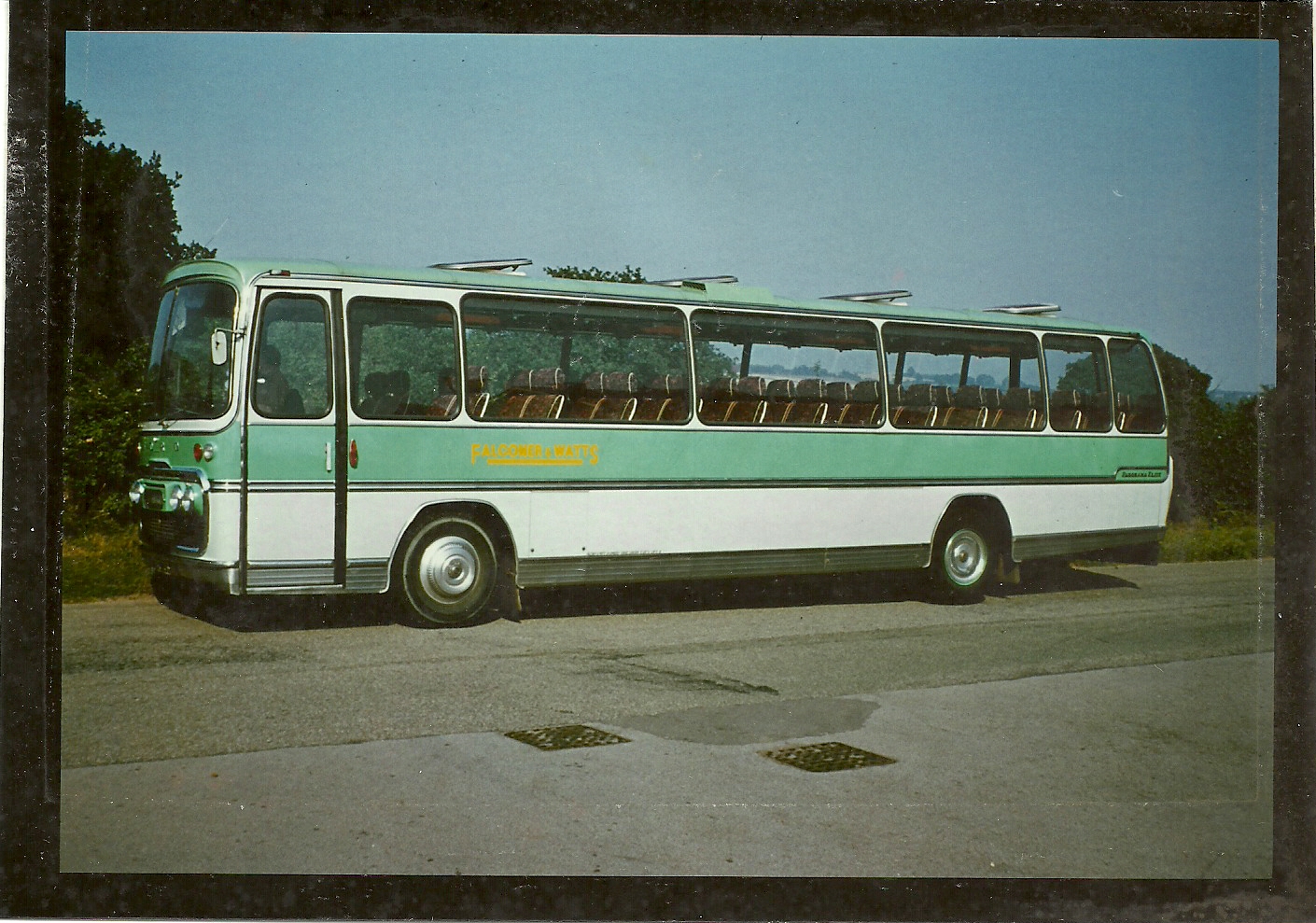
MBM 585G, Falconer and Watts’ first 11-metre coach, a Ford R226 with a Plaxton body, purchased after many years’ loyalty to Bedford chassis (Falconer and Watts did not like Bedford’s 11-metre offering, the twin-steer VAL) …
(photograph copyright Rob Falconer)
The situation with the declining profits of the filling station side of the business came to a head when the lease on the ground to the rear (where the coaches were kept) was due to expire around 1972. It was known that this would be earmarked for residential development, and it was realised that new premises would have to be sought. As the land was leased, it was thought that no financial gain could be derived.
However, this was not quite so, as it was discovered by Audrey, Graham’s wife, that the lane from Station Road was not sufficiently wide for public access to the land, and so the house and filling station were sold off at the same time.
As it was intended to concentrate on the coach operation, the wedding cars were sold off. Also, the hire car business was becoming a less attractive proposition, as new bye-laws meant that large, comfortable, but older, limousines were no longer acceptable, and newer, but usually much smaller, cars must be purchased, and so the goodwill of the hire car business was given to two local people, Ted Chamberlain and Barbara Silverthorn, who formed Llantax to continue running hire cars (they operated from the same premises as Falconer and Watts for a while).
Falconer and Watts had for some time owned a small garage and land in Kimberley Terrace. This had last been used to garage the wedding limousines (then a Humber Imperial and two Humber Pullmans). Coincidentally, the house adjoining this was then for sale (and all but sold already).
Graham and Audrey stepped in and bought this house immediately, having to sub-let it for a year until it was time to leave Station Road on August 01 1972. The house then served as an accommodation address for the company for some years, while premises for the coaches were rented, firstly from Henry Morgan of Whittle Road, Leckwith, and then from Cardiff Council in Godfrey Street (these premises have now been demolished, and the space is now occupied by Ty Llewellyn, alongside the flyover between Cardiff Bay and the Prison).
The yard at Whittle Road was rented under the name of Coach Services, a holding company set up by Falconer and Watts and Wenallt Coaches, run by John Crookes. This was not only to manage the yard, but also to buy diesel and other commodities. Space there was also sub-let to Castle Coaches, another local coach company, run by Graham Lang.
A greater degree of autonomy was sought when it was time to leave there, and the yard in Godfrey Street (including a two-storey garage with undercover space for four coaches) was rented from Cardiff City Council. However, for a period, space was allocated to C.K. Coaches (run by Keith and Carol Morris), who later challenged Cardiff Council to provide the first non-Council bus services in Cardiff for many years.
The company’s diamond jubilee was celebrated in 1979 when a new 53-seater purchased that year, XKG 808T, a Ford Duple Dominant II, had a legend to that effect prominently displayed on each side.
THE COACHES 1973-1982
Falconer and Watts won the Cymru Trophy at the 1981 Brighton Coach Rally with driver John Crookes (right) and Rob Falconer (left)
Graham was pleased to see a return to buying new coaches again in 1973 (the last previous new purchase had been in 1957), when a new Bedford 29-seater Duple was purchased. A new 53-seater followed two years later, and thereafter one new coach was added to the fleet each year. The livery was now the striking green, grey and yellow which had been modified from that of a second-hand purchase from Cosy Coaches of Poole.
Both these coaches featured the same moquette on the seats. Firth Royd 711, similar to a green tartan, was specified for new coaches CKG 470L, HDW 873N, MTX 106P, and RHB 114R, and the seats in XKN 158J were re-covered in this moquette (allowing one regular customer to thank the company for sending the “new” coach – it was in fact the oldest in the fleet, but the smell of the new upholstery was very persuasive!). Later, the pattern was deleted from the range, but one artful coach dealer’s representative managed to find enough somewhere to ensure that the next deal was his, and XKG 808T was similarly treated.
Although the company had been almost 100% loyal to Bedford Duples for some time (as had many small firms during this period), increasing dissatisfaction with Bedfords led to a change during the 1970s, and the fleet became almost 100% standardised on Ford chassis, mainly because the 360 turbo diesel seemed more suited to motorway work than the larger normally-aspirated Bedford engines.
It was at this time that Continental coach tours became more commonplace. Although few advertised Continental tours were run (one to Holland was certainly advertised in the early eighties), the fleet was increasingly used for private hire abroad. Initially, fairly short-haul journeys were made, to Paris and Northern France, Belgium and the Netherlands, but eventually, Falconer and Watts coaches were seen as far afield as Kitzbuhel in Austria, Oberammergau in Germany, and Ravenna on the Italian Adriatic coast.
Small but still luxurious coaches were of particular interest to Graham, to some extent because of the need to supply vehicles for the tourism industry which were comfortable, but still able to access places of interest or hotels in fairly inaccessible places. To this end, a Leyland Asco Clubman 19-seater was bought in 1975. This found a ready niche in the local market, and so this was followed in 1977 by the first production Ford A-series with a Moseley 25-seat body, which was far more professional. Falconer and Watts had been involved in discussions with Moseley’s at an early stage of design, and they entered the coach in the 1977 British Coach Rally at Brighton. However, Moseley’s also decided to enter two pre-production models in operators’ liveries at the last minute. These seemed hastily prepared, and Falconer and Watts felt that this reduced the impact of their entry. It failed to win any awards, as did subsequent entries to the Rallies in 1978 and 1980, but Falconer and Watts was more successful the following year when they carried off the 1981 Cymru Trophy at Brighton, with a new Ford Duple Dominant IV (one of the first in Wales to be fitted with double-glazing). The coach had been driven (through heavy April snow!) straight from Duple’s at Blackpool to Brighton for the weekend. Unfortunately, another vehicle collided with it en route, but this did not stop it from gaining the award. The weekends at Brighton were a lot of fun, but extremely hard work, with very little sleep being taken between social events and midnight polishing!
EXCURSIONS AND TOURS
An Excursions and Tours licence (Road Service Licence TGR662/1) was applied for and granted probably in the forties (the earliest date traced was 1947). The two pick-up points were at the Garage in Station Road, Llanishen (later just Station Road, and then finally around the corner in Heol Hir, Llanishen) and Museum Avenue (by the steps of the Museum) in the centre of Cardiff. These tours were at one time very popular, but declined in popularity, particularly from the 1960s onwards, as the use of private cars became more widespread.
An attempt to bring these tours up-to-date was made when Rob, Graham’s son, joined the business in 1973, and some new day trips were applied for and added to the list. At that time, Falconer and Watts was the only company licensed to operate excursions and tours out of Cardiff except for the local Council and the National Bus Company.
The Excursions and Tours licences (TGR4112/1, later TGR662/2) of G & H Coaches of Pentyrch were purchased in 1977. The six pick-up points were Glan-y-Llyn (Square), Morganstown (Post Office), Nantgarw (Rhyd-y-Helyg), Pentyrch (Penygarn), Taff’s Well (King Street), and Tongwynlais (The Square : Mill Road side).
However, nothing could seem to improve the loadings for day tours, even at Bank Holidays, when, rather than lose possible long-term custom by cancelling, coaches were often sent out with uneconomic loadings (at least once with only three paying passengers – plus friends to fill the coach!). Eventually, these fell once again into disuse.
However, extended tours did become more popular. Sealink contacted Falconer and Watts in 1976 with a view to a linked advertising campaign with Jenkins of Skewen (now part of the Shearing Group) and R. I. Davies of Tredegar (later taken over by Hill’s of Tredegar and Warners Fairfax). This was to feature Bonus Breakaways to the Channel Islands. These inclusive tours were very good value for money, and became a tremendous success, both financially and in terms of loadings, perhaps because each coach tour was accompanied by a member of the Falconer family to ensure that everything went smoothly (because only coaches of a limited size were allowed on the Channel Islands, Falconer and Watts’ coach had to leave the passengers at Weymouth or Portsmouth, and a local coach would meet them on the island). Keeping passengers happy even extended to Rob’s driving from Cardiff to Weymouth by car to reunite some passengers with luggage that they had left inside a doorway in Llanishen in their rush to get the front seats on the coach!
A second campaign, similar but specifically using the Jersey Holiday Village, was run with Sealink in early 1977 – the price of £39.50 included return coach travel from Cardiff to Weymouth, three nights’ half-board accommodation, coach transfers, a tour of the island (with lunch), and a litre of spirits and 200 cigarettes.
An Excursions and Tours Licence was required to run these extended tours (including an additional pick-up point in Newport, in the lay-by at the entrance to the bus station), and these were granted despite objections from other operators, including one from S. A. Bebb in respect of future applications!
These tours were run from 1976 to 1981, to both Guernsey and Jersey, and rarely had other than full loads.
THE SALE
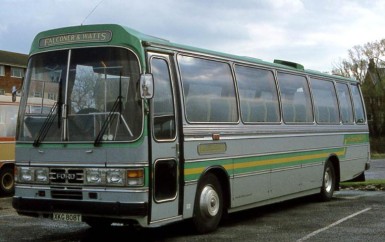
XKG 808T, a Ford R1114 Duple Dominant II, was purchased new in 1979, Falconer and Watts’ Diamond Jubilee Year, and had a legend to this effect displayed on the side
Even with a relatively small fleet, there was plenty of responsibility, and it was felt that there was too much for one person to handle on his own.
Percy Watts passed away in the late seventies (January 01 1978), but he had only dabbled in providing a hire car service for ‘his’ customers for the last few years before retirement.
The amount of work involved was especially apparent when both Graham and Audrey were simultaneously temporarily incapacitated in the late seventies, and it was decided it would be as well to sell the business whenever a suitably reputable purchaser could be found.
Advertisements in the trade press were made as vague as possible, but, as the only private operator with Excursions and Tours Licences in the area, one would have thought it fairly obvious to which operator they referred!
Eventually, Warners Fairfax of Tewkesbury made an offer which was accepted, and Falconer and Watts passed into their hands on April 07 1982.
Warners had already acquired a number of coach operators including part of R. I. Davies of Tredegar (which had been “shared” with Hill’s of Tredegar), Glevum Coaches of Gloucester, and Roy Grindle of Cinderford. They also had offices or travel agencies in Bristol (where the original Fairfax Tours had started), Cardiff, Cheltenham, Ebbw Vale (acquired with R. I. Davies), Monmouth, and Stroud. Charles Warner apparently thought that a local coach operator would be a good addition to the travel agency in Cardiff. Rob and Audrey were surprised to be appointed manager and assistant manager of the office.
However, there were later changes in management policy. Responsibility for running the coaches was transferred to Tewkesbury and Bristol, and the travel agencies in South Wales were soon closed down.
As the company reputation and tradition had been looked after so carefully by the Falconer family for so long, it is perhaps better that the name should just pass away, rather than be passed into someone else’s hands.
Sadly, Graham Falconer passed away on August 01 2002.
And Audrey Falconer passed away on November 29 2016.

